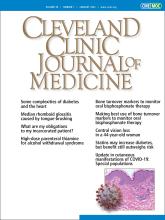Article Figures & Data
Tables
Markers of bone formation Measured in Diurnal variation Renal function variation Pros Cons Bone-specific alkaline phosphatase (BSAP) Serum No No No postprandial changes
Stable sample due to half-life of 1–2 days
Widely availableRoughly 20% cross-reaction with other types of alkaline phosphatase N-terminal propeptide of type I procollagen (PINP) Serum Yes Yes Well studied in clinical trials
Relatively low intra-individual variability
PINP measures response to therapy more effectively than BSAPHepatic function can affect levels depending on the assay and form of propeptide being measured
Increased in patients on hemodialysisProcollagen type I carboxyterminal propeptide (PICP) Serum Yes Renal variation unknown Less studied than other bone formation markers Osteocalcin Serum and urine Yes Yes Correlates well with bone turnover Less stable; must process within hours
Production is dependent upon vitamin K and can decrease in response to vitamin K antagonists (eg, warfarin)Markers of bone resorption Measured in Diurnal variation Renal function variation Pros Cons C-terminal telopeptide of type I collagen (CTX) Serum and urine Yes Yes Stable biomarker
Rapidly decreases with antiresorptive therapyPostprandial variability
Can be impacted by hepatic functionN-terminal telopeptide of type I collagen (NTX) Serum and urine (24-hour urine collection or second morning void) Yes Yes Minimal postprandial variability Fasting measurements recommended
Impacted by hepatic functionPyridinoline and deoxypyridinoline Urine (24-hour urine collection or second morning void with creatinine correction) Yes Yes Can be renally adjusted Impacted by hepatic function Tartrate-resistant acid phosphatase 5b Serum Yes No No change with renal function Predominately from but not exclusive to bone
Unstable at room temperature
Increases immediately after exerciseBased on data from references 18–20.
Background: Left proximal humerus fracture 4 years prior due to a fall from standing height during a syncopal event
Left femural neck T-score of −2.5 on dual-energy x-ray absorptiometry
No history of celiac disease, paraproteinemia, or bariatric surgery
Renal function and vitamin D levels were normal
Patient concerned about falls and balance; another fall 6 months prior without fracture.
After ruling out secondary causes of osteoporosis, oral alendronate 70 mg once weekly was initiated.Bone mineral density and bone turnover markers: Before treatment At 3 months At 1 year T-scores: Lumbar spine −1.6 −1.7 Left femoral neck −2.5 −2.4 Right femoral neck −2.2 −2.1 Bone turnover marker: C-terminal telopeptide of type I collagen 520 pg/mL 177 pg/mL
(66% reduction from baseline)273 pg/mL
(48% reduction from baseline)Background: History of breast cancer treated with lumpectomy, radiation therapy, and 5 years of tamoxifen
Outside DXA scans showed a progressive decline in her lumbar spine T-score from −3.1 to −3.3
Femoral neck bone density was stable
Past medical history was otherwise unremarkable
No history of lactose intolerance, celiac disease, or chronic glucocorticoid use
She did not take calcium supplements, but took over-the-counter vitamin D
No history of antifracture therapy.
The patient was prescribed oral alendronate 70 mg once weekly.Bone mineral density and bone turnover markers: Before treatment 3 months 1 year T-scores: Lumbar spine NA −2.6 Left femoral neck NA −1.5 Right femoral neck NA −1.5 Bone turnover marker:
C-terminal telopeptide of type I collagen653 pg/mL 361 pg/mL
(45% reduction from baseline)188 pg/mL
(72% reduction from baseline)NA = Not available: baseline dual-energy x-ray absorptiometry (DXA) was done at an outside facility and thus was not appropriate for comparison.






